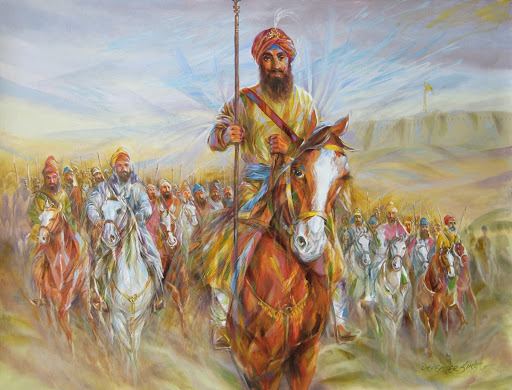DAYA KAUR, RAM (d. 1823), widow of Gurbakhsh Singh of the Nishanavali principality of the Sikhs who ruled over Ambala, assumed control of the misl and the family estate upon her husband`s death in 1786. She ruled over the territory remarkably well for nearly 37 years. Sir Lepel Griffin in his The Rajas of the Punjab says, “She was an excellent ruler and her estate was one of the best managed in the protected territory.” In November 1808, Maharaja Ranjit Singh ejected Daya Kaur from the city and seized all her property and possessions.
He divided her country between Raja Bhag Singh of Jind, his maternal uncle, and Bhag Singh`s friend and ally, Bhai Lal Singh of Kaithal. In 1809, the cis Sutlej chiefs passed under British protection. Daya Kaur appealed to Colonel David Ochterlony, agent to the Governor General at the Ludhiana Political Agency, who forced the chiefs of Jind and Kaithal to restore to Daya Kaur territories which originally belonged to her. Daya Kaur died in 1823 and on her death her estates and property lapsed to the British government.
References :
1. Griffin, Lepel, The Rajas of the Punjab [Reprint]. Delhi, 1977
Daya Kaur: Sikh Ruler of Ambala’s Resilient Legacy, a story that exemplifies the strength and determination of a woman who steered her principality through turbulent times and left a lasting impact on Punjab’s history.
Ascension to Power and Early Rulership
Following the death of her husband, Gurbakhsh Singh of the Nishanavali principality, in 1786, Daya Kaur assumed control of the misl (confederacy) and the family estate that governed Ambala. As a widow at a time when leadership was commonly the realm of men, she broke conventional boundaries through sheer administrative acumen and valor. According to historical accounts, she managed the estate exceptionally well for nearly 37 years. Sir Lepel Griffin, in his authoritative work The Rajas of the Punjab, remarked, “She was an excellent ruler and her estate was one of the best managed in the protected territory,” highlighting the judicious policies and the efficient governance that characterized her rule .
Governance, Challenges, and Administration
Under Daya Kaur’s reign, Ambala became known not only for its political stability but also for its progressive management. She skillfully navigated the intricate dynamics of power during a period marked by shifting allegiances and external pressures. Despite the challenges imposed by emerging dominant forces in the region, she maintained a robust administrative structure, ensuring that her estate remained prosperous and well-defended. Her leadership embodied the evolving role of women in Sikh polity, where resilience and decisiveness were as crucial as martial prowess and diplomatic foresight .
Conflict with the Emerging Sikh Empire
Daya Kaur’s consolidated rule in Ambala eventually intersected with the territorial ambitions of Maharaja Ranjit Singh. In November 1808, Ranjit Singh—then consolidating power over the cis-Sutlej territories—ejected her from Ambala and seized a significant portion of her property and possessions. The lands were distributed between influential figures such as Raja Bhag Singh of Jind and Bhai Lal Singh of Kaithal, realigning regional power in favor of the rising Sikh empire. Undeterred by this setback, Daya Kaur sought redress; she appealed to Colonel David Ochterlony, the agent to the Governor General at the Ludhiana Political Agency. Ochterlony’s intervention forced the chiefs of Jind and Kaithal to restore to her the territories that originally belonged to her estate—a remarkable, if temporary, vindication of her rule .
Enduring Legacy and Historical Impact
Daya Kaur’s resilient legacy is multifaceted:
- A Trailblazer for Women:
As a woman who assumed leadership in a male-dominant era, she became a symbol of strength and capability. Her successful administration set a precedent for female rulers in Punjab and demonstrated that traditional gender roles could be redefined in times of crisis. - Expert Governance:
Her ability to manage a well-organized estate, maintain effective domestic administration, and safeguard her people during a period of political flux left an indelible imprint on the history of Ambala. Her methods in statecraft and crisis management continue to intrigue historians and serve as an example of enlightened leadership. - Political Resilience:
Even after facing displacement at the hands of Maharaja Ranjit Singh, her recourse to British intervention underlines a pragmatic approach to power struggles. Although her efforts could not permanently reverse the tide of imperial consolidation, they highlight a strategic commitment to restoring rightful authority. - Cultural Memory:
Her story is preserved in various historical accounts and serves as an inspiring narrative for later generations. The saga of Daya Kaur demonstrates how personal fortitude and astute governance can leave a lasting legacy, even amid the inexorable changes wrought by larger political forces.



